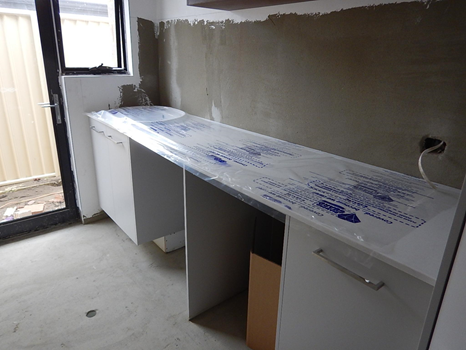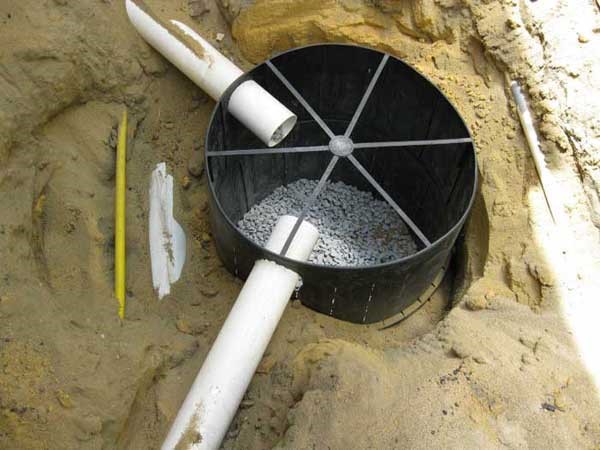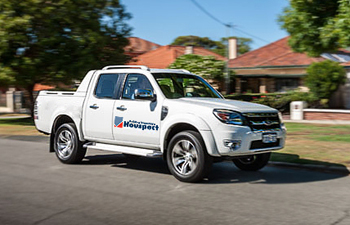
New Homes in WA - Roof Frame Inspections
By HOUSPECT WA Building Inspections|July 14, 2017
1 What are we talking about?
In WA, a roof frame is predominately the timber frame above the ceiling and below the roof cover. The roof frame provides the support for the roof cover, which in WA is more often than not these days made of steel (Colorbond) but could also be made of cement/ clay tiles with some other minor options still available (I.e. slate).
The majority of WA roof frames are constructed on site by roof carpenters (stick roof frames), although prefabricated roof trusses (wood or steel) are other options.
While it may appear that there is a random assortment of timbers making up the roof frame, the Building Code of Australia and the very detailed Australian Framing Standard AS 1684 provides very clear guidance on exactly what is required for stick framed houses. Further, for every home constructed, there will be Engineers Plans which also provides very specific guidelines and requirements for roof frame construction.
2 So what is the issue?
Roof frames are complex and construction does not always go to plan.
The WA Building Commission published a report in 2016 (COMPLIANCE REPORT: A summary of technical building inspections 2015-16) which indicated that of 651 roof inspections undertaken by the Commission, 37% were unsatisfactory. The findings were updated in mid-year 2016/17 and published. Positively, the overall position improved, but sadly 33% were still unsatisfactory. The key takeout and based on these numbers is that almost 1 in 3 metal roof homes could have defects.
In WA, roof carpenters are not licenced or regulated and yet they are tasked with building a very complex component of a new home. Builders, with the support of their site supervisors, self-assess the construction of the roof frame. Given its inherent complexity, it is hardly surprising that on occasion issues can arise.
3 Why is it important?
Given the transition to metal roofs in WA, the most significant challenge is wind uplift to the roof during extreme wind events. In short, there is the very real potential in an extreme wind event that the roof can be peeled off the home if the requirements of the Building Code, Australian Standards and Engineer have not been complied with.
The combination of the above requirements are very specific. They detail exactly how the frame is to be constructed, supported and connected. The requirements even go down to defining exactly what type of bolts are to be used and how many nails are to be utilised in each of the proprietary connecting brackets. This level of detail provides you, the home owner, with assurances that the roof will remain intact during high wind events.
4 There can’t be that many issues can there?
Sadly, yes there can. See here for a small selection of actual roof framing issues identified in WA over recent months in 2017.
http://www.houspect.com.au/wa/roof-frames/
5. What is the immediate solution for people building a new home
The simple solution is to have your roof frame checked by an independent Houspect Building Inspector. Armed with the approved Engineers Plans, a good knowledge of the Building Code of Australia AS 1684 and many years of experience, your Houspect Building Inspector can review the work undertaken on site so that you can be assured that the roof frame has been constructed as approved.
6 When should the roof Frame be inspected?
The best time to inspect the roof frame is prior to the roof cover (tiles/metal) being installed. This provides the inspector with the best opportunity to review the entire structure and to ensure it is compliant.
It is possible to review the roof frame once the roof cover has been installed, but it’s potentially harder as visibility may have been restricted in low pitch area of the roof, especially at the wall plates above the outer perimeter load bearing walls. On multi storey buildings the scaffolding will often come down immediately after the roof cover has been installed and as such it may be necessary to undertake the roof frame and roof cover inspections at the same time, given the limited window of opportunity while the scaffolding is in situ.
7 Can a Roof Frame Inspection be done at the Practical Completion or Handover Inspection?
It is possible to undertake a limited inspection of the roof frame at the Practical Completion or Handover Inspection but there can be limitationssuch as:
· Insulation may block visibility of key components
· Air conditioning ducting may block visibility of key components
· Parts of the roof may not have manholes (i.e. above carports) to enable viewing of the roof frame
· Low pitch “flat roofs” may have no roof space access
The other key issue associated with identifying a roof frame defect at the Practical Completion or Handover Inspection stage is that it can delay handover of the property back to you while the remedial work is undertaken, which may require removal of parts of the roof cover.
8 Summary
Roof frames are a critical part of your home but because they are rarely seen, little attention is given to them.
Ph 9240 8855 Web: www.houspect.com.au/wa Email: enquiry@houspectwa.com.au
Houspect WA - Build, Buy, Invest in property with confidence.
In WA, a roof frame is predominately the timber frame above the ceiling and below the roof cover. The roof frame provides the support for the roof cover, which in WA is more often than not these days made of steel (Colorbond) but could also be made of cement/ clay tiles with some other minor options still available (I.e. slate).
The majority of WA roof frames are constructed on site by roof carpenters (stick roof frames), although prefabricated roof trusses (wood or steel) are other options.
While it may appear that there is a random assortment of timbers making up the roof frame, the Building Code of Australia and the very detailed Australian Framing Standard AS 1684 provides very clear guidance on exactly what is required for stick framed houses. Further, for every home constructed, there will be Engineers Plans which also provides very specific guidelines and requirements for roof frame construction.
2 So what is the issue?
Roof frames are complex and construction does not always go to plan.
The WA Building Commission published a report in 2016 (COMPLIANCE REPORT: A summary of technical building inspections 2015-16) which indicated that of 651 roof inspections undertaken by the Commission, 37% were unsatisfactory. The findings were updated in mid-year 2016/17 and published. Positively, the overall position improved, but sadly 33% were still unsatisfactory. The key takeout and based on these numbers is that almost 1 in 3 metal roof homes could have defects.
In WA, roof carpenters are not licenced or regulated and yet they are tasked with building a very complex component of a new home. Builders, with the support of their site supervisors, self-assess the construction of the roof frame. Given its inherent complexity, it is hardly surprising that on occasion issues can arise.
3 Why is it important?
Given the transition to metal roofs in WA, the most significant challenge is wind uplift to the roof during extreme wind events. In short, there is the very real potential in an extreme wind event that the roof can be peeled off the home if the requirements of the Building Code, Australian Standards and Engineer have not been complied with.
The combination of the above requirements are very specific. They detail exactly how the frame is to be constructed, supported and connected. The requirements even go down to defining exactly what type of bolts are to be used and how many nails are to be utilised in each of the proprietary connecting brackets. This level of detail provides you, the home owner, with assurances that the roof will remain intact during high wind events.
4 There can’t be that many issues can there?
Sadly, yes there can. See here for a small selection of actual roof framing issues identified in WA over recent months in 2017.
http://www.houspect.com.au/wa/roof-frames/
5. What is the immediate solution for people building a new home
The simple solution is to have your roof frame checked by an independent Houspect Building Inspector. Armed with the approved Engineers Plans, a good knowledge of the Building Code of Australia AS 1684 and many years of experience, your Houspect Building Inspector can review the work undertaken on site so that you can be assured that the roof frame has been constructed as approved.
6 When should the roof Frame be inspected?
The best time to inspect the roof frame is prior to the roof cover (tiles/metal) being installed. This provides the inspector with the best opportunity to review the entire structure and to ensure it is compliant.
It is possible to review the roof frame once the roof cover has been installed, but it’s potentially harder as visibility may have been restricted in low pitch area of the roof, especially at the wall plates above the outer perimeter load bearing walls. On multi storey buildings the scaffolding will often come down immediately after the roof cover has been installed and as such it may be necessary to undertake the roof frame and roof cover inspections at the same time, given the limited window of opportunity while the scaffolding is in situ.
7 Can a Roof Frame Inspection be done at the Practical Completion or Handover Inspection?
It is possible to undertake a limited inspection of the roof frame at the Practical Completion or Handover Inspection but there can be limitationssuch as:
· Insulation may block visibility of key components
· Air conditioning ducting may block visibility of key components
· Parts of the roof may not have manholes (i.e. above carports) to enable viewing of the roof frame
· Low pitch “flat roofs” may have no roof space access
The other key issue associated with identifying a roof frame defect at the Practical Completion or Handover Inspection stage is that it can delay handover of the property back to you while the remedial work is undertaken, which may require removal of parts of the roof cover.
8 Summary
Roof frames are a critical part of your home but because they are rarely seen, little attention is given to them.
- There are significant problems in the correct construction of roof frames in WA as evidenced by the WA Building Commission reports which indicated potentially up to 1 in 3 homes have roof framing issues.
- The construction of roof frames is governed by the Building Code of Australia, Australian Standards 1684 and the Engineers Plans specific for the individual property. These requirements need to be followed exactly.
- If the roof frame is not constructed correctly, it can impact the eventual sale of the property and possibly outside of any construction warranty period so the cost is then borne by the owner
- Independent Roof Inspections by a Houspect Building Inspector are another set of qualified and experienced eyes reviewing the construction of a key element of your new home
- Roof Frame inspections should be conducted during construction ideally just before the roof cover is installed but absolutely before the ceilings are installed.
Ph 9240 8855 Web: www.houspect.com.au/wa Email: enquiry@houspectwa.com.au
Houspect WA - Build, Buy, Invest in property with confidence.



